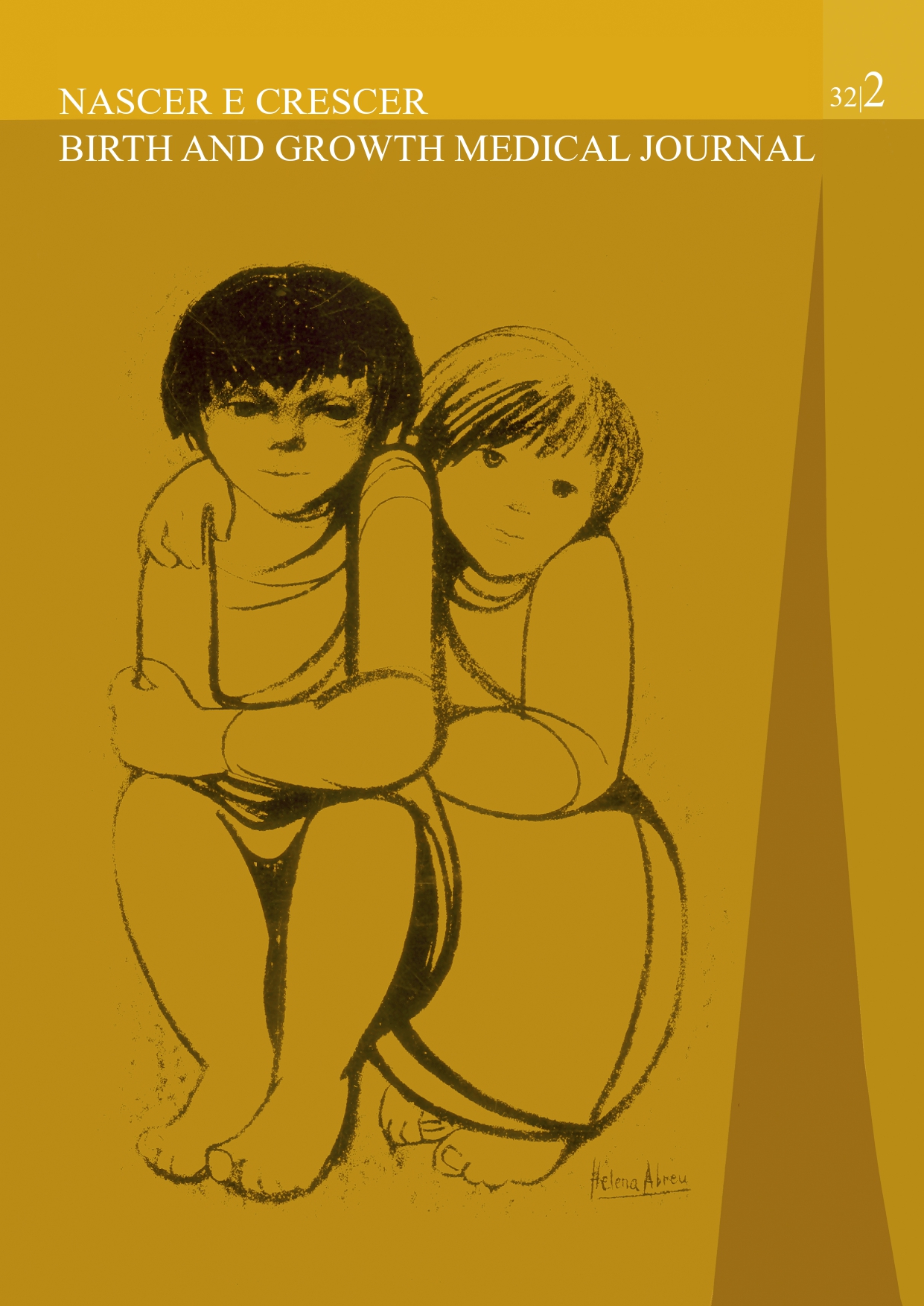Non-celiac gluten sensitivity
DOI:
https://doi.org/10.25753/BirthGrowthMJ.v32.i2.25767Keywords:
gluten-free diet, gluten-related disorder, non-celiac gluten sensitivityAbstract
Introduction: Recurrent abdominal pain accounts for up to 5% of consultations in pediatric primary care. An organic cause is found in only 5−10% of children. Non-celiac gluten sensitivity is a condition characterized by intestinal symptoms (including abdominal pain) and extra-intestinal symptoms related to the ingestion of gluten-containing foods in subjects who are not affected by celiac disease or wheat allergy. Treatment is based on a gluten-free diet.
Objectives: The aim of this work was to review relevant studies in Pediatrics on the subject published in recent years, with the purpose of increasing knowledge among pediatric specialists and contributing to raising awareness and maintaining a high index of clinical suspicion of the condition and improving the diagnosis and management of the condition while reducing the use of gluten-free diet without medical advice.
Development: A review was carried out on PubMed and Cochrane databases using terms related to non-celiac gluten sensitivity, and the evidence about gluten, non-celiac gluten sensitivity, biomarkers, epidemiology, and Salerno Criteria (used in the diagnosis of the disease) was assembled and reported.
Conclusion: Establishing the diagnosis of non-celiac gluten sensitivity and other gluten-related disorders is crucial to design measures to facilitate access to gluten-free diets for patients who really need them. More standardized clinical trials in Pediatrics are needed to draw specific conclusions about the disease.
Downloads
References
Iyer R, Nallasamy K. Child with Abdominal Pain. Indian J Pediatr. 2018;85(1):71-6.
Reust CE, Williams A. Recurrent Abdominal Pain in Children. Am Fam Physician. 2018;97(12):785-93.
Turco R, Salvatore S, Miele E, Romano C, Marseglia GL, Staiano A. Does a low FODMAPs diet reduce symptoms of functional abdominal pain disorders? A systematic review in adult and paediatric population, on behalf of Italian Society of Pediatrics. Ital J Pediatr. 2018;15:44-53.
Slim M, Rico-Villademoros F, Calandre EP. Psychiatric Comorbidity in Children and Adults with Gluten-Related Disorders: A Narrative Review. Nutrients. 2018;10(7):875-903.
Elli L, Branchi F, Tomba C, Villalta D, Norsa L, Ferretti F, et al. Diagnosis of gluten related disorders: Celiac disease, wheat allergy and non-celiac gluten sensitivity. World J Gastroenterol. 2015;21(23):7110-9.
Biesiekierski JR, Peters SL, Newnham ED, Rosella O, Muir JG, Gibson PR. No effects of gluten in patients with self-reported non-celiac gluten sensitivity after dietary reduction of fermentable, poorly absorbed, short-chain carbohydrates. Gastroenterology. 2013;145(2):320-8 e1-3.
Catassi C, Elli L, Bonaz B, Bouma G, Carroccio A, Castillejo G, et al. Diagnosis of Non-Celiac Gluten Sensitivity (NCGS): The Salerno Experts’ Criteria. Nutrients. 2015;7(6):4966-77.
Skodje GI, Sarna VK, Minelle IH, Rolfsen KL, Muir JG, Gibson PR, et al. Fructan, Rather Than Gluten, Induces Symptoms in Patients With Self-Reported Non-Celiac Gluten Sensitivity. Gastroenterology. 2018;154(3):529-39.e2.
National Library of Medicine (2022) – PubMed database - National Center for Biotechnology Information (NCBI), at the U.S. National Library of Medicine (NLM), located at the National Institutes of Health (NIH). [Consulted in set. 2022]. Available in https://pubmed.ncbi.nlm.nih.gov/.
Cochrane Library - international network of Research - Member of the UK National Council for Voluntary Organizations (2022) - [Consulted in set. 2022]. Available in https://www.cochranelibrary.com.
Cruchet S, Lucero Y, Cornejo V. Truths, Myths and Needs of Special Diets: Attention-Deficit/Hyperactivity Disorder, Autism, Non-Celiac Gluten Sensitivity, and Vegetarianism. Ann Nutr Metab. 2016;68 Suppl 1:43-50.
Czaja-Bulsa G. Non coeliac gluten sensitivity - A new disease with gluten intolerance. Clin Nutr. 2015;34(2):189-94.
Erlichman J, Hall A, Dean A, Godwin B, Mascarenhas M. Integrative Nutrition for Pediatrics. Curr Probl Pediatr Adolesc Health Care. 2016;46(6):165-71.
DeGeeter C, Guandalini S. Food Sensitivities: Fact Versus Fiction. Gastroenterol Clin North Am. 2018;47(4):895-908.
Ruemmele FM. Non-Celiac Gluten Sensitivity: A Challenging Diagnosis in Children with Abdominal Pain. Ann Nutr Metab. 2018;73 Suppl 4:39-46.
Francavilla R, Cristofori F, Verzillo L, Gentile A, Castellaneta S, Polloni C, et al. Randomized Double-Blind Placebo-Controlled Crossover Trial for the Diagnosis of Non-Celiac Gluten Sensitivity in Children. Am J Gastroenterol. 2018;113(3):421-30.
Llanos-Chea A, Fasano A. Gluten and Functional Abdominal Pain Disorders in Children. Nutrients. 2018;10(10):1491-506.
Vriezinga SL, Schweizer JJ, Koning F, Mearin ML. Coeliac disease and gluten- related disorders in childhood. Nat Rev Gastroenterol Hepatol. 2015;12(9):527-36.
Silva AT, Santa Marta C, Morais-Almeida M, Pinto JR. Wheat hypersensitivity: clinical manifestations and allergenic proteins. Review. Rev Port Imunoalergologia. 2005;13(2):133-40.
Di Sabatino A, Volta U, Salvatore C, Biancheri P, Caio G, De Giorgio R, et al. Small Amounts of Gluten in Subjects With Suspected Nonceliac Gluten Sensitivity: A Randomized, Double-Blind, Placebo-Controlled, Cross-Over Trial. Clin Gastroenterol Hepatol. 2015;13(9):1604-12 e 3.
Zanini B, Baschè R, Ferraresi A, Ricci C, Lanzarotto F, Marullo M, et al. Randomised clinical study: gluten challenge induces symptom recurrence in only a minority of patients who meet clinical criteria for non-coeliac gluten sensitivity. Aliment Pharmacol Ther. 2015;42(8):968-76.
Downloads
Published
How to Cite
Issue
Section
License
Copyright (c) 2023 Cecilia Bigio

This work is licensed under a Creative Commons Attribution-NonCommercial 4.0 International License.
Copyright and Authors' Rights
All articles published in Nascer e Crescer - Birth and Growth Medical Journal are Open Access and comply with the requirements of funding agencies or academic institutions. For use by third parties, Nascer e Crescer - Birth and Growth Medical Journal adheres to the terms of the Creative Commons License "Attribution - Non-Commercial Use (CC-BY-NC)".
It is the author's responsibility to obtain permission to reproduce figures, tables, etc. from other publications.
Authors must submit a Conflict of Interest statement and an Authorship Form with the submission of the article. An e-mail will be sent to the corresponding author confirming receipt of the manuscript.
Authors are permitted to make their articles available in repositories at their home institutions, provided that they always indicate where the articles were published and adhere to the terms of the Creative Commons license.


